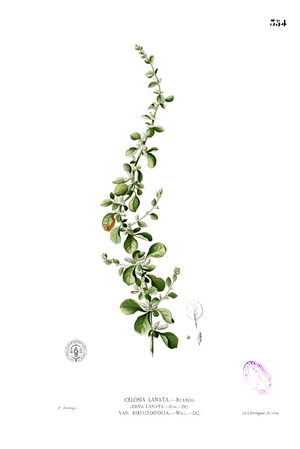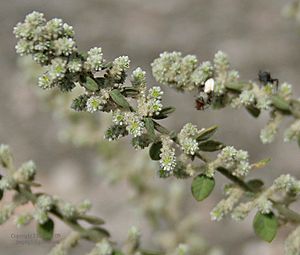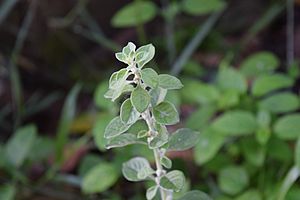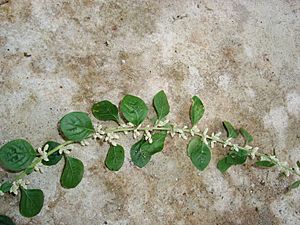Mountain knotgrass facts for kids
Aerva lanata, also known as mountain knotgrass, is a small plant that grows close to the ground. It's a type of herb that can live for many years (perennial). This plant belongs to the Amaranthaceae family, which includes many other common plants. You can find Aerva lanata growing naturally in parts of Asia and Africa.
This plant is often seen as a common weed in places like India. Its roots have a smell similar to camphor. The dried flowers look like soft spikes and are sometimes sold under names like Buikallan and Boor. In Kerala, India, Aerva lanata is considered one of the ten sacred flowers, known as Dasapushpam.
Quick facts for kids Mountain knotgrass |
|
|---|---|
 |
|
| Aerva lanata var. rotundifolia | |
| Scientific classification | |
| Genus: |
Aerva
|
| Species: |
lanata
|
| Synonyms | |
|
|
What Does Mountain Knotgrass Look Like?
Mountain knotgrass is a plant that grows for about a year, but its root system can be quite strong and woody. Its stems usually spread out wide, sometimes reaching up to 6 feet long!
The leaves are oval-shaped and grow alternately along the stem. They are about 0.5 to 1.5 inches long. Small groups of two or three tiny flowers grow where the leaves meet the stem. These flowers are about 0.1 inches long and can be pink, green, or a dull white color. They usually pollinate themselves, meaning they don't need help from insects or wind to make seeds. This plant typically flowers from May to October.
Where Does Mountain Knotgrass Grow?
Aerva lanata is originally from warm places like tropical Africa, South Africa, Madagascar, Saudi Arabia, and tropical Asia. It likes places that are a bit damp. You can find it in open forests on mountain slopes, in areas where the ground has been disturbed, or in coastal scrubland. It grows from sea level up to about 900 meters (about 2,950 feet) high. It's also a common weed in farm fields and bare patches of ground.
How People Use Mountain Knotgrass
This plant is useful for both people and animals. The whole plant, especially its leaves, can be eaten. People sometimes add the leaves to soups or eat them like spinach or other vegetables. Animals like livestock, wild game, and chickens also eat this plant.
In some traditional medicine practices, Aerva lanata is used to help with snakebites. In India, the juice from the crushed roots of Aerva lanata is used in traditional medicine to help treat jaundice.
Some people also use the plant as a special charm. It's believed to protect against bad spirits, bring good luck to hunters, and help with the well-being of widows.




